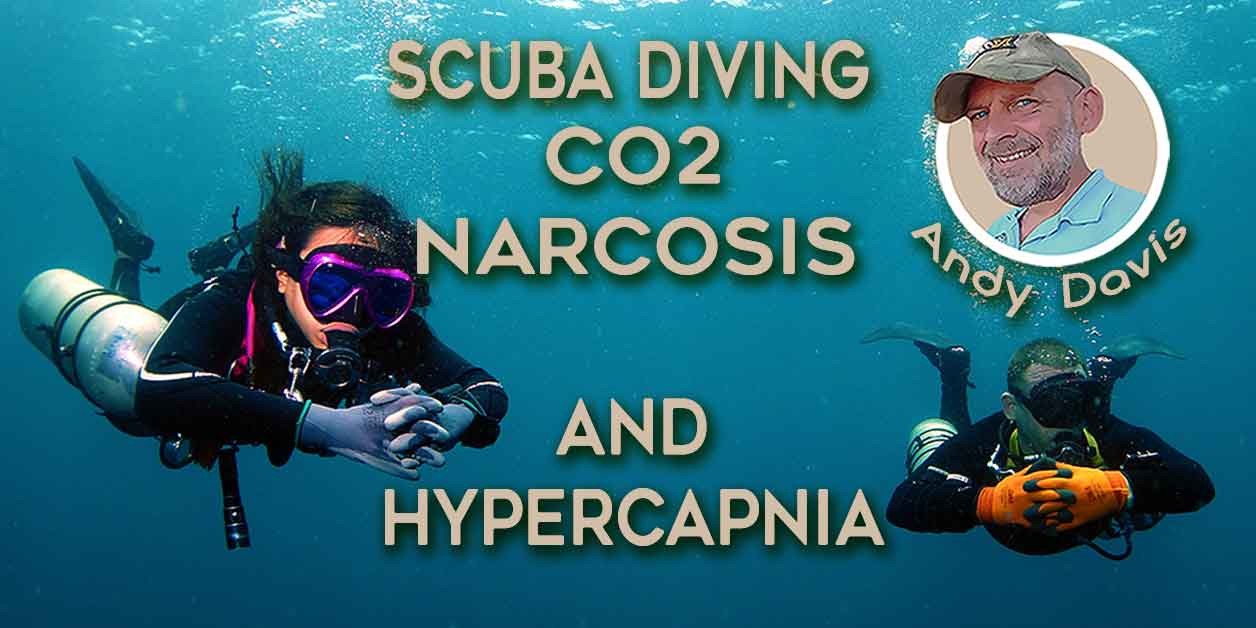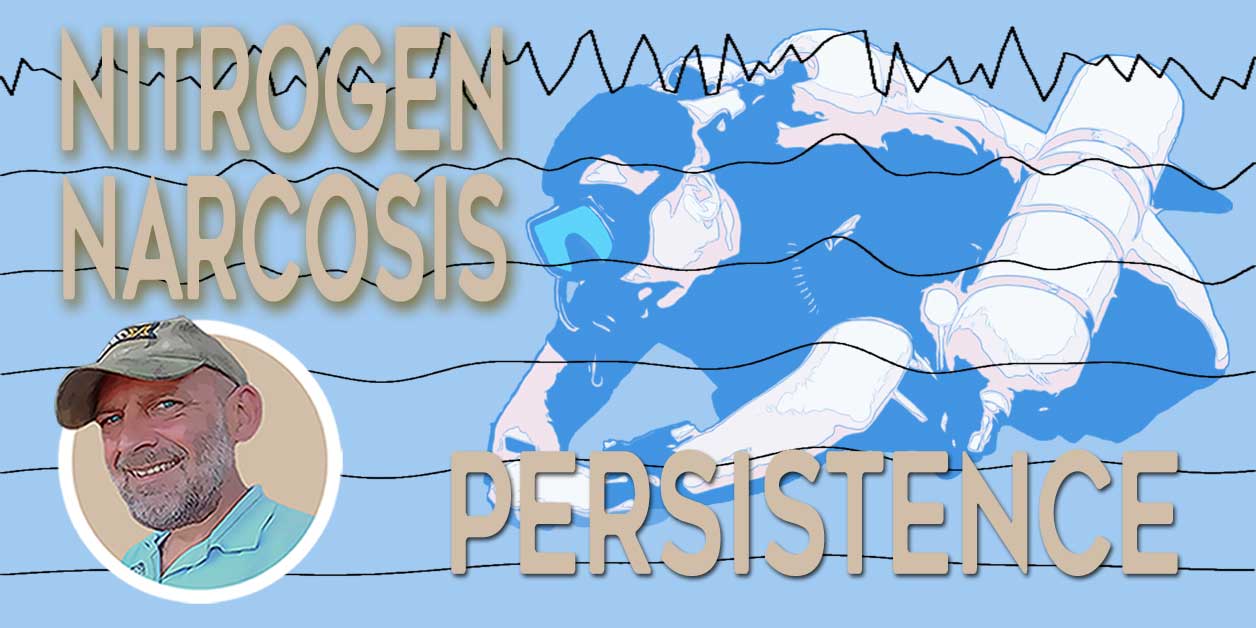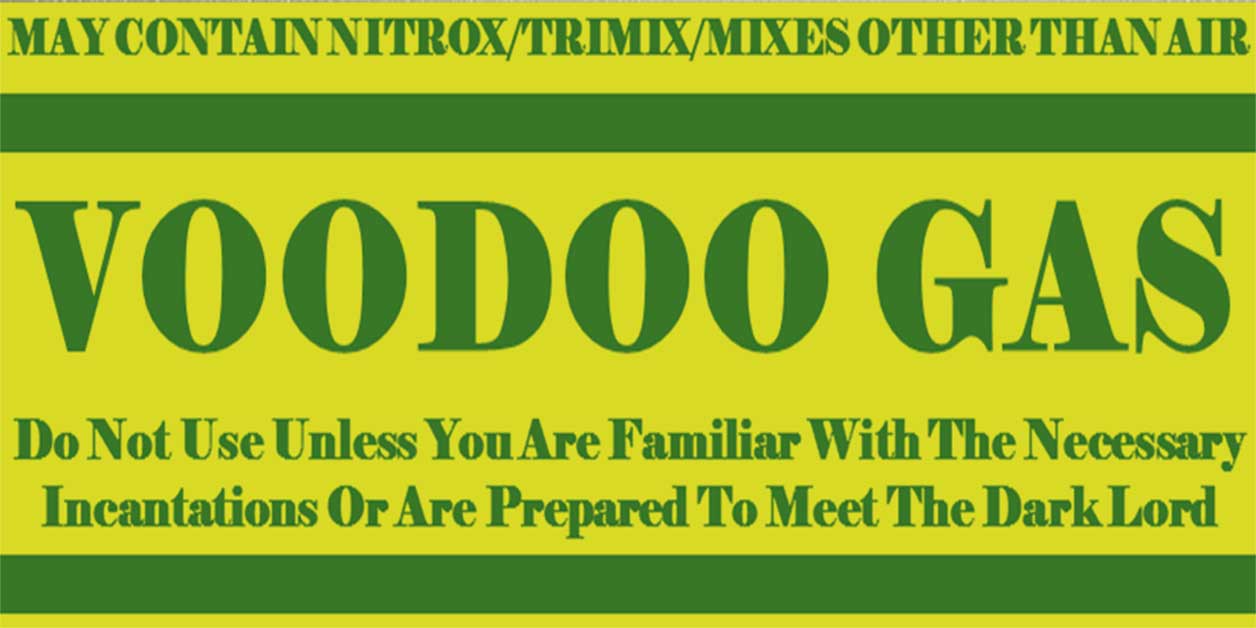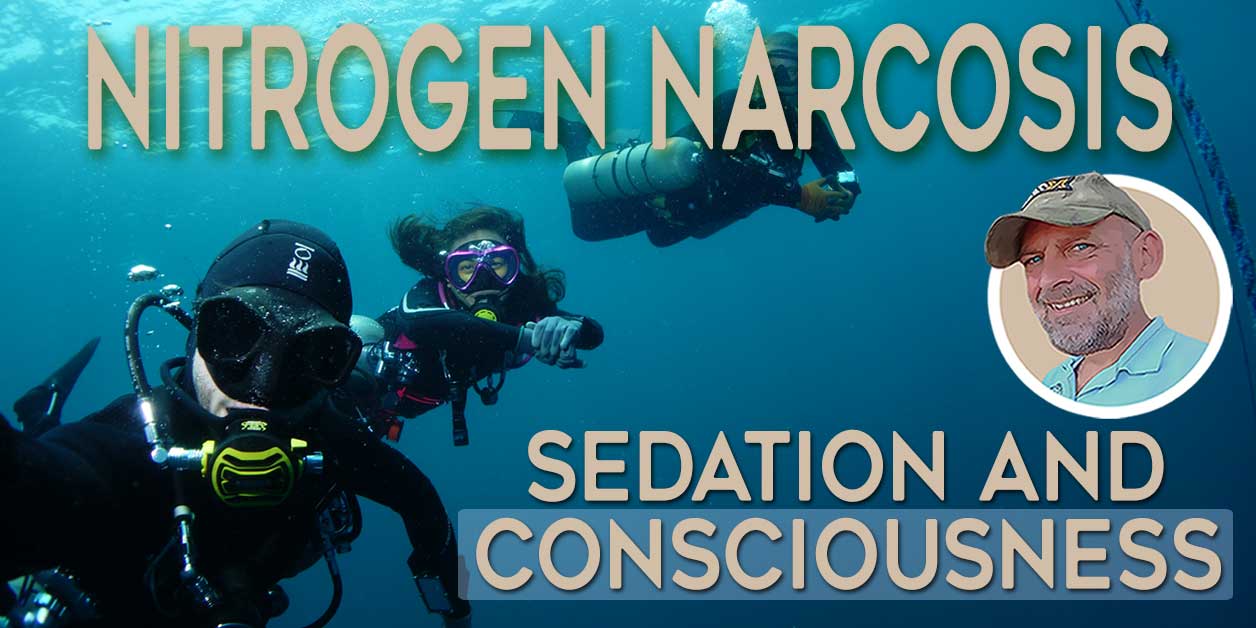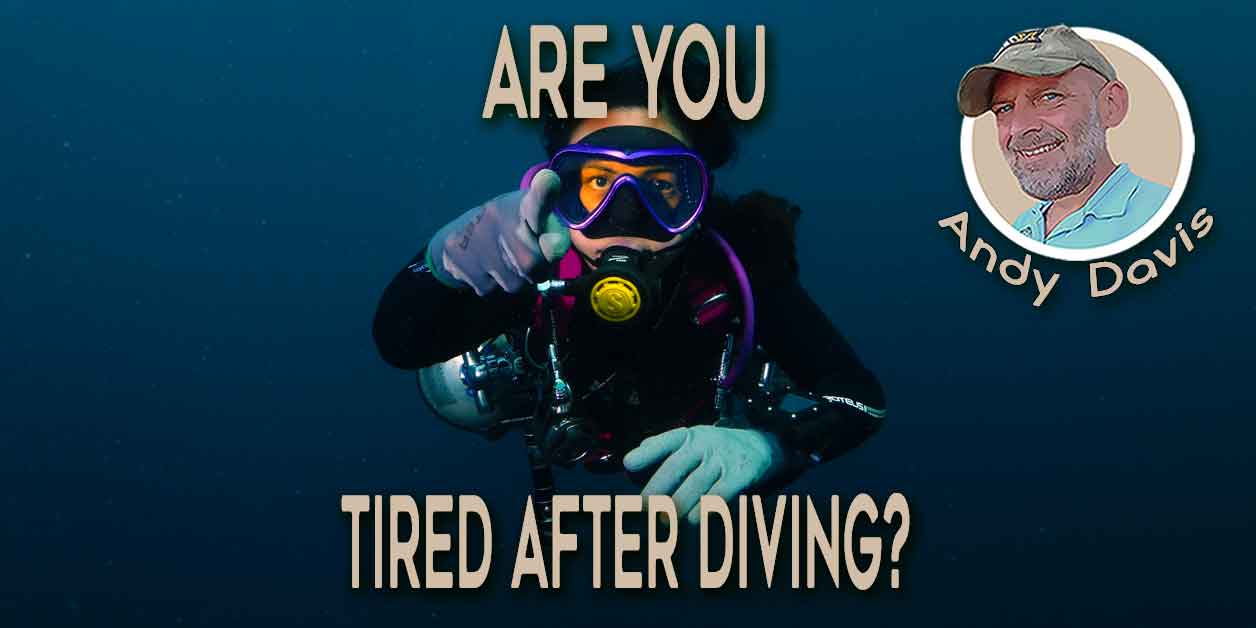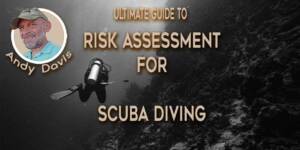Nitrogen Narcosis: Why It Is Hard to Know You Are Narked
Is it really possible to gauge your susceptibility to nitrogen narcosis and make good judgments to manage it?
Nitrogen narcosis is a hyperbaric neurological phenomenon. Its existence, symptoms, and onset are known, even if medical science has not yet explained the physiological mechanisms causing it.
Individual susceptibility to the effects of nitrogen narcosis varies in severity. It is also inconsistent in onset for a given individual on a given day. A diving medical study also seems to indicate that nitrogen narcosis may be persistent, even when ascending from depth.
Nitrogen narcosis key takeaways
- Nitrogen narcosis is a hyperbaric neurological phenomenon that affects any diver subjected to an elevated partial pressure of inspired nitrogen.
- The level of narcosis potential for a particular inert gas stems from its lipid solubility.
- Variance in individual blood-brain chemistry and neurological makeup plays a role in nitrogen narcosis susceptibility.
- Nitrogen narcosis starts immediately below the surface and increases in severity as depth increases.
- The greatest variation between divers is the individual perception of susceptibility to narcosis, which makes it difficult to gauge.
- Nitrogen narcosis causes a decline in consciousness.
- The ‘martini rule’ is a baseless lay theory and should not be used to describe nitrogen narcosis.
- Nitrogen narcosis is not like alcohol inebriation; it is actually an effect of sedation or anesthesia.
- Reduced mental perception prevents the diver from being aware of the mental decline, making nitrogen narcosis insidious.
- Functionality under narcosis stems from the degree to which diving abilities are ingrained to an unconscious level.
- Divers can’t develop immunity to narcosis, and the answer to differing performance levels under narcosis is what mental functions are affected.
Meyer-Overton Law of Lipid Solubility
It has been shown that the level of narcosis potential for a particular inert gas stems from its lipid solubility. It is the efficiency of gas in diffusing into fatty tissues (i.e. the brain tissue) in the body.
The most recent research is studying the effects of lipid-dissolved inert gasses on neurotransmitter receptor protein mechanisms in the brain.
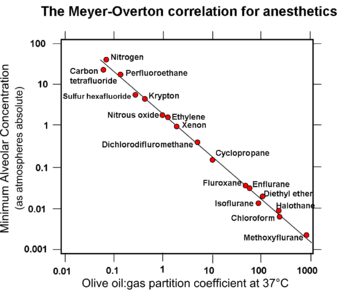
Variance in individual blood-brain chemistry and/or neurological make-up obviously play a role in nitrogen narcosis susceptibility. Nonetheless, it remains a known neurological occurrence that affects any diver subjected to an elevated partial pressure of inspired nitrogen.
Be under no illusions, narcosis affects humans as soon as inert-gas partial pressure begins to increase. It starts immediately below the surface and increases in severity as depth and inert gas partial pressures increase. We all get narked – and that starts a lot shallower than many divers are inclined to believe.
Perceptions of nitrogen narcosis susceptibility
The greatest variation between divers is the individual perception of susceptibility to narcosis. This is the person’s awareness of when, or if, they are suffering a decline in mental capacity.
Narcosis causes a gradual decline in consciousness. Diminished consciousness impairs the brain’s ability to reflect on its own state, reducing self-awareness. This makes it harder for individuals to gauge their level of consciousness accurately.
In short, the first effect of narcosis is to diminish your ability to sense any growing cognitive impediment.
Divers are taught incorrect analogies for narcosis
One of the problems with gauging the perception of susceptibility to narcosis is that of misleading education. In reality, nitrogen narcosis doesn’t conform to the classical “martini rule“. For that reason, instructors should not use that analogy to describe the issue.
One of the problems with gauging the perception of susceptibility to narcosis is that of misleading education. In reality, nitrogen narcosis doesn’t conform to the classical ‘martini rule’. For that reason, diving instructors should not use that analogy to describe the issue.
The Martini Rule, also known as the Martini Effect or Martini’s Law, metaphorically suggests that the effects of nitrogen narcosis worsen with depth, akin to consuming one martini for every 10 meters (33 feet) descended below the surface.
Inaccurate analogies describing the symptoms of nitrogen narcosis prevent divers from accurately diagnosing its onset. If divers don’t feel ‘drunk’, then they don’t perceive that nitrogen narcosis is affecting them.
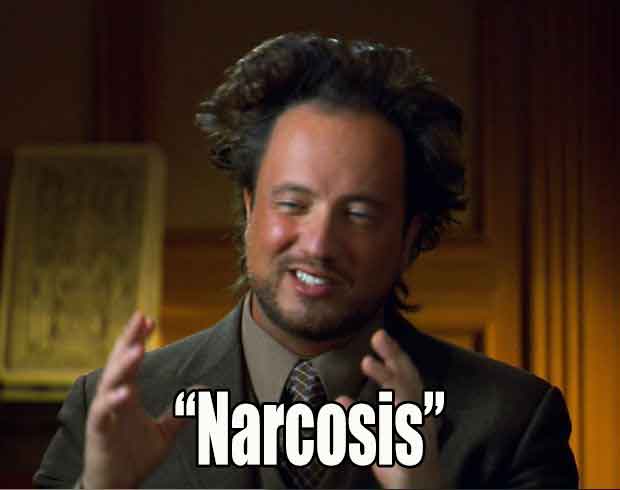
Nitrogen narcosis is not like alcohol inebriation
Nitrogen narcosis isn’t a form of intoxication (drunkenness); it is actually an effect of sedation or anesthesia.
The word ‘narcosis’ originates from the Greek word ‘narke’, meaning a “temporary decline or loss of senses and movement, numbness”.
The currently accepted definition of narcosis is “a state of stupor, drowsiness, or unconsciousness”. At no point do those definitions indicate a propensity for giggling or donating your regulator to fish.
That is not to say that nitrogen narcosis doesn’t amplify the moods or emotions of a diver. But these are just one distinct subset of a much wider, and more subtle host of symptoms.
If divers believe the analogy of alcohol intoxication, then they will miss the discrete symptoms indicating reduced mental faculty.
Nitrogen narcosis is not like alcohol inebriation
Nitrogen narcosis isn’t a form of intoxication (drunkenness); it is actually an effect of sedation or anesthesia.
The word ‘narcosis’ originates from the Greek word ‘narke‘, meaning a “temporary decline or loss of senses and movement, numbness”.
The currently accepted definition of narcosis is “a state of stupor, drowsiness, or unconsciousness“. At no point do those definitions indicate a propensity for giggling or donating your regulator to fish.
See my other article on the sedative impediment of narcosis on consciousness:
Nitrogen Narcosis – Sedation and Consciousness
That is not to say that nitrogen narcosis doesn’t amplify the moods or emotions of a diver. But these are just one distinct subset of a much wider and more subtle host of symptoms.
If divers believe the analogy of alcohol intoxication, then they will miss the discrete symptoms indicating reduced mental faculty.
The Nitrogen Narcosis Placebo Effect
Using improper analogies to describe the symptoms of nitrogen narcosis leads to divers experiencing those fictitious symptoms as a ‘placebo effect’.
The placebo effect is when a person experiences physical or mental symptoms without physiological cause.
Placebo is Latin for ‘I will please‘ and, in medicine, refers to a treatment that appears real but is designed to have no therapeutic benefit. For instance, a patient’s health may appear to improve after taking a placebo or ‘dummy’ treatment.
The placebo effect is observed across a wide range of medical trials, with reported frequencies varying. Studies indicate placebo responses in clinical trials can range from 17% to 80%, depending on factors like trial design and patient expectations.
In short, it is not an uncommon or rare phenomenon. The effect demonstrates the power of psychological expectations on physiological outcomes. It’s widely studied in clinical trials to distinguish between the actual effectiveness of a medical treatment and the placebo response.
American Psychological Society: Study Finds that Alcohol Placebo Impairs Memory
BBC NEWS | Science/Nature | ‘Fake alcohol’ can make you tipsy
Nitrogen narcosis and autonomic competency
Nitrogen narcosis is insidious because reduced mental perception prevents the diver from being aware of the mental decline. It’s difficult to gauge a decrease in your IQ.
What matters, from a safety perspective, is whether the diver remains functional at a given depth. By ‘functional’, I mean retaining sufficient competency to apply the necessary skills and protocols needed to sustain safety.
Can divers develop immunity to narcosis?
There has been a substantial debate on whether certain divers develop immunity to narcosis. Numerous scientific studies have proved that physiological immunity to narcosis does not exist.
However, it is possible that divers can adapt psychologically to retain more functionality when cognitively impaired by narcosis.
What matters, from a safety perspective, is whether the diver remains functional and competent at a given depth. By ‘functional’, I mean retaining the ability to apply the necessary skills and protocols needed to retain safety.
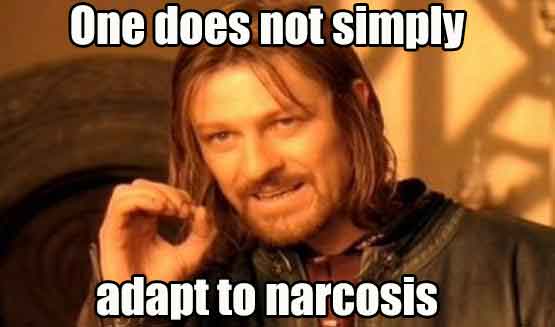
Experienced divers can develop a form of tolerance or adaptation to nitrogen narcosis as a conditioned response. This adaptation occurs through repeated exposure to narcosis. Several factors contribute to reducing susceptibility to nitrogen narcosis among seasoned divers.
Neurophysiological Adaptations
Over time, the brain undergoes neurophysiological changes in response to nitrogen exposure. This adaptation can include alterations in neurotransmitter activity and receptor sensitivity, potentially mitigating the impact of nitrogen on cognitive and motor functions at depth.
Specifically, there is evidence of alterations in dopamine, serotonin, and GABA systems, which play crucial roles in mood regulation and cognitive function
Neural Plasticity
Narcosis impairs the transmission of signals between different areas of the brain. However, with repeated exposure, the brain can utilize neural plasticity to re-organize how information is processed and channeled within the brain when narcosis is present.
Neural plasticity, also known as brain plasticity, is the brain’s capacity to change and adapt throughout life by forming new neural connections. This dynamic process allows the brain to reorganize in response to experiences, learning, and even brain injury.
Neural plasticity encompasses both structural changes, like the growth of new neurons and synapses, and functional changes, which involve adjustments in neural pathways and the strengthening or weakening of existing connections.
This ability is crucial for learning, memory formation, and recovery from brain injuries or psychological traumas. While neural plasticity does not grant immunity, divers can enhance their cognitive function through repeated exposure to narcotic conditions, facilitating better adaptation to the altered mental states induced by nitrogen narcosis.
Behavioral Awareness and Coping Strategies
Experienced divers often develop a heightened awareness of their mental state and physical abilities while diving. They learn to recognize early signs of nitrogen narcosis, such as impaired judgment or impaired short-term memory, and employ effective coping strategies.
Experienced divers employ cognitive strategies to maintain focus and decision-making capabilities. These include developing more intense mental focus and slower, more deliberate, problem-solving techniques. Deterioration in memory is counter-acted by more frequent checking and re-checking of critical dive information.
Additionally, experienced divers will employ more comprehensive signaling and communication procedures. These help reduce the likelihood of dangerous misunderstandings and confusion.
Training and Regular Practice
Formal dive training emphasizes the recognition and management of nitrogen narcosis. Divers undergo simulated dives and practical exercises to familiarize themselves with the sensations and effects of narcosis. Through consistent exposure during training and regular diving expeditions, divers enhance their ability to function efficiently and safely at greater depths].
In summary, the “immunity” to nitrogen narcosis observed in experienced divers stems from a combination of neurophysiological adaptations, enhanced awareness of narcosis symptoms, and rigorous training. These factors collectively enable divers to maintain cognitive clarity and physical dexterity in challenging underwater environments, promoting safer and more effective deep-sea exploration.
Ingrained skills diminish slower under narcosis
I believe that functionality under narcosis stems from the degree to which diving abilities are ingrained to an unconscious level. Reduced mental faculty impinges less on functions that are ingrained deeply as second nature to the diver.
Often, only when the diver observes impairment to autonomic capabilities do they perceive the impact of narcosis. The need to problem-solve, or the presentation of novel situations, brings a much more immediate perception of narcosis impairment.
This, in principle, is a situation where the diver becomes aware that they should be able to perform. However, the struggle to do so without obvious cause.
Ingrained skills perish less under narcosis
For a novice diver, with few ingrained second-nature capabilities, the perception of narcosis occurs quickly – at shallower depths. Mild narcosis exposes the fact that they are still problem-solving, rather than unconsciously performing, rudimentary diving functions.
As a diver gains experience and training, a wider spectrum of competencies becomes second nature. More skills are unconsciously ingrained. More problems are encountered and overcome; becoming planned reactions rather than novel issues to be solved.
Diving competencies and nitrogen narcosis
However, diving competencies fall into two categories; fundamental and specific.
- Fundamental competencies are things like buoyancy, trim, situational awareness, and gas management.
- Specific competencies are necessitated by the respective hazards of the dive environment and/or the tasks on the dive.
Examples of these might be guideline procedures in cave diving or gas-switching procedures for decompression diving. As such, diving competency must be considered relevant to the level of diving undertaken.
For instance, an Advanced Open Water diver with weak foundational competencies can be just as compromised as a cave diver with weak specific competencies.
Where the novice recreational diver might forget to check their air supply, the novice cave diver might deviate from proper guideline protocols. The same effect occurs, regardless of the level of skills compromised.
Routinely employed dive functions don’t expose moderate narcosis impairment. That impairment has to reach a very severe level, whereby the narcosis degrades actual autonomic dive functionality. In contrast, novel problems arising during the dive expose narcosis impairment more obviously.
Perceptions of narcosis impairment vary greatly. I believe that diver experience and competency play a major role in that perception.
See also my articles
Nitrogen Narcosis – Sedation and Consciousness
Does Nitrogen Narcosis Persist?
Narcosis and the impact of CO2 retention
There is increasing debate on the impact of CO2-increasing narcosis. I don’t doubt that CO2 retention significantly increases the severity of narcosis and reduces the depth of onset. CO2 has the effect of increasing blood flow to the brain, which exaggerates the effects of other inspired gasses. By itself, CO2 also has a very high narcotic potency. It is 20x more narcotic than nitrogen.
Again, the effects of CO2 retention favor those with more diving experience and skill. Within the parameters of a given dive; skill and technique can modify the need to resort to physical exertion.
- Workload decreases
- Breathing techniques are better
- Stress management is improved
- Experience acquisition improves self-awareness
In particular, the recognition that respiration becomes elevated and the wisdom that exertion needs to be reduced or stopped.
A skillful diver is more likely to manage their CO2 retention more effectively than a less skilled diver. This might play a large role in deciding the severity and perceived onset depth of nitrogen narcosis.
Nitrogen narcosis management
All of the preceding issues factor into a very personal decision needed on narcosis management.
The competency to make decisions on narcosis management becomes clearer as experience and skillfulness develop; relative to a given level of diving.
To the casual observer, deep air diving may seem like a very “do as I say, not as I do” attitude by higher-level divers. Indeed, even the definition of what constitutes ‘deep air’ diving is subject to great debate – for the reasons outlined already in my article.
Setting maximum narcotic depths
Setting mandatory maximum narcotic depths (max ppN2) under-estimates the real relationship between narcosis impairment and the level of autonomic dive skill acquisition. It is, however, a logical approach for diving agencies that have to consider a cross-spectrum of divers and diving competency levels.
Narcosis management advice
The most prudent advice on narcosis management remains:
- Dive within the limits of your training and experience
- Respect your comfort zones
- Practice acquired skills diligently and routinely
- Minimize exertion and workload on dives
- Limit your depth until necessary dive competencies are ingrained
What to consider when dealing with narcosis
In addition, I’d suggest the following points are considered:
- The hazard of narcosis is relevant to the degradation of competencies necessary to preserve safety on a given dive.
- Fully understand the skill competencies necessary for the dives you undertake.
- Consider the degree to which you have ingrained competencies into autonomic functions.
- Experience acquisition precludes the need for problem-solving.
- If you perceive any impairment to your expected diving competency, assume it is narcosis.
- Abort the dive if diving functionality is compromised by narcosis.
It is hard to know you are suffering from nitrogen narcosis
In conclusion, nitrogen narcosis is a complex and often misunderstood phenomenon that affects any diver exposed to elevated partial pressures of inspired nitrogen.
It starts immediately below the surface and increases in severity with depth, making it difficult to gauge.
Variance in individual blood-brain chemistry and neurological makeup also play a role in susceptibility.
The insidious nature of nitrogen narcosis means that divers often don’t realize they are affected until it’s too late.
The ‘martini rule’ is a baseless lay theory, and nitrogen narcosis is not like alcohol inebriation but rather an effect of sedation or anesthesia.
Divers cannot develop immunity to narcosis, and functionality under narcosis depends on the degree to which diving abilities are ingrained at an unconscious level.
It’s crucial for divers to understand the diving risks associated with nitrogen narcosis and take the necessary precautions to ensure their safety while exploring the underwater world.
About The Author

Andy Davis is a RAID, PADI TecRec, ANDI, BSAC, and SSI-qualified independent technical diving instructor who specializes in teaching sidemount, trimix, and advanced wreck diving courses.
Currently residing in Subic Bay, Philippines; he has amassed more than 10,000 open-circuit and CCR dives over three decades of challenging diving across the globe.
Andy has published numerous diving magazine articles and designed advanced certification courses for several dive training agencies, He regularly tests and reviews new dive gear for scuba equipment manufacturers. Andy is currently writing a series of advanced diving books and creating a range of tech diving clothing and accessories.
Prior to becoming a professional technical diving educator in 2006, Andy was a commissioned officer in the Royal Air Force and has served in Iraq, Afghanistan, Belize, and Cyprus.
In 2023, Andy was named in the “Who’s Who of Sidemount” list by GUE InDepth Magazine.
Purchase my exclusive diving ebooks!
Nitrogen narcosis FAQ
Nitrogen narcosis depresses consciousness. If narcosis is very severe, the diver can pass out. They will consequently drown.
Nitrogen narcosis begins as soon as a diver descends from the surface. However, the effect is not typically debilitating above 30m (100ft).
There is a scientific debate over whether nitrox reduces narcosis. According to Meyer-Overton, oxygen is more narcotic than nitrogen. However, it is metabolized in the brain. As a working principle, nitrox is not considered to reduce narcosis.
Nitrogen narcosis persists on the ascent. If you feel the effects of narcosis, abort the dive and surface. Assume that your cognitive ability is impaired.
Divers have two options for preventing narcosis:
1) Stay at shallower depths above 30m (100ft).
2) Use helium-based trimix gas mixtures.
A high partial pressure of nitrogen inhibits communication within the brain. Narcosis is a result of breathing compressed air at depth.
Nitrogen narcosis affects all divers once they descend from the surface. However, the effects do not become debilitating until depths beyond 30m (100ft).
Scientific studies have demonstrated that nitrogen narcosis persists during ascent. The effect can last until over an hour after diving. In contrast, CO2 narcosis dissipates quickly on the ascent.
Originally posted 2018-03-07 23:55:40.







